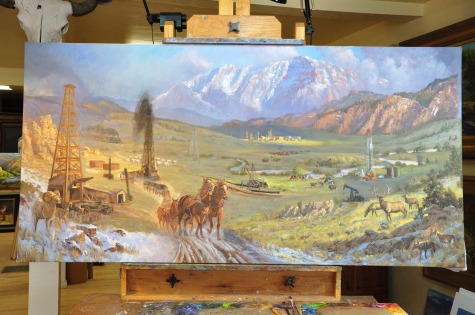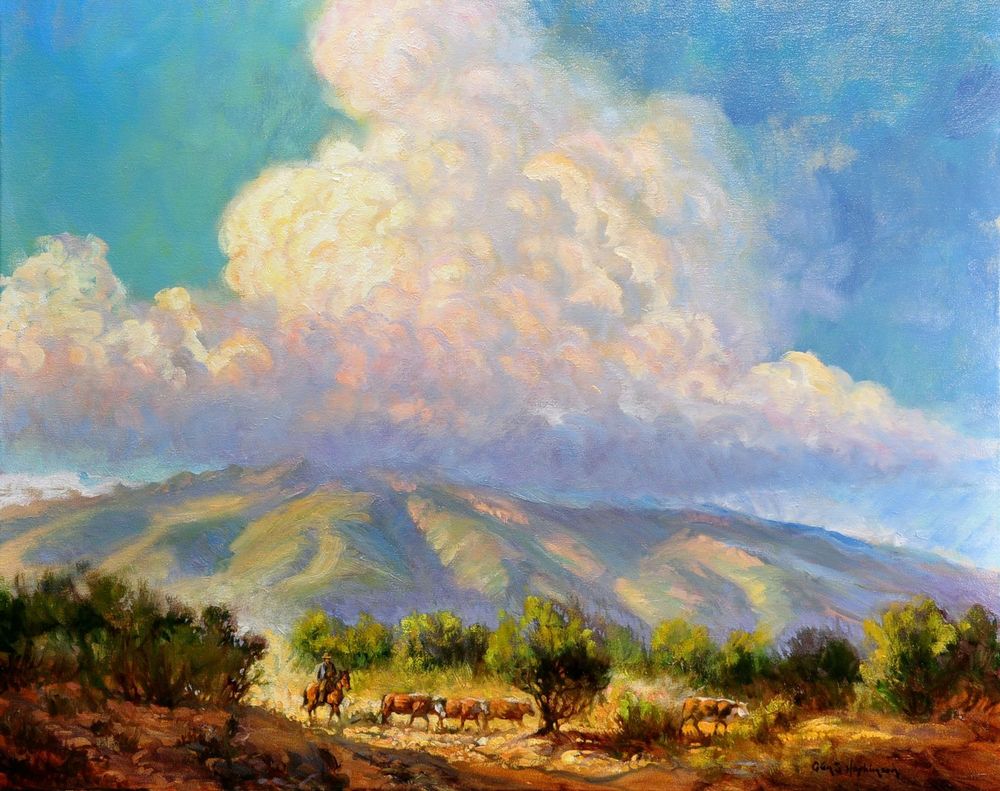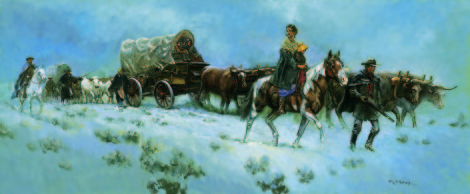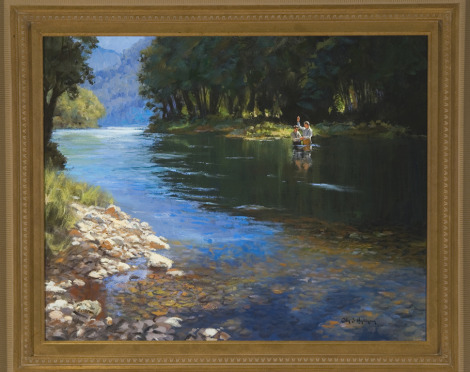Marathon Painting-Finished! (Uh oh. Not quite!)

Here I am working on a few small details, anxious to sign this painting which is looking very good. A person who sees how much time I'm spending on this painting asks me if I'm a perfectionist. I don't think a painting can ever achieve perfection, at least not in the artist's eyes. I am, however, trying to make it the best painting I can possibly make. I'm almost there and then, today as I am painting I notice a couple of things that are bothering me...
More soon.
The Marathon Project- 100 Years in Wyoming

In these three sketches (still thinking of doing a triptych) I decided to drop the oil workers in the side paintings and bring out the Wyoming animals.
August of 2011, Lucinda Greer, Senior Land Professional at Marathon Oil Company contacted me to talk about doing a painting representing the history of Marathon Oil in Wyoming. It was perfect timing. I had just moved back to Byron, Wyoming, the middle of one of the biggest oil fields in the state. During the weeks prior I had been out in those oil fields painting all the rocks and landscapes I had played in and on as a boy.
I was delighted and anxious to start smooshing paint all over a bunch of canvases. Our initial discussions concluded with me doing research in Marathon's photo files and agreeing to do several presentation sketches. These sketches allow the client to see different ideas on how I could approach the project. I also welcome their comments and thoughts on which directions we take. This exchange of ideas is always valuable.
March 1st 2012 was the date we agreed that I would be finished. "Ha!", thought I. "I will easily finished by March 1st." As of this moment, March 1st is only days away and I still have a bunch or work to do to finish the painting. (I think I can...I think I can...I think I can...).
100 Years of Marathon Oil in Wyoming

In August, shortly after I had begun setting up my studio in Byron, Wyoming I received a call from Lucinda Greer, an executive from Marathon Oil Company whose office is in Cody. She wanted me to do a painting or paintings that would represent the history of Marathon Oil in Wyoming over the last 100 years.
I felt I was perfect for the job. In the 50s, when I was a boy and my friends and I would ride our bikes or horses out to the sandhills North of Byron I was always amazed at the "forest" of oil derricks around our town. We were in the middle of the oil business and most of my friend's fathers were employed by Ohio Oil Co. (later to become Marathon Oil".
I started the project by painting several sketches to be considered to define the direction I would go in the final painting. The panel that is pictured here was a suggestion that we could go forward with a "triptych"; a trio of paintings that would hang together. This idea would show the oil worker of the past on one side and the worker of the present on the other with a Wyoming landscape and different aspects of the oil business in the middle picture.
More on this project soon...
A Mormon Missionary from Communist East Germany...cont.

I met Bjorn Bauerfeind in Salt Lake City. He had flown from Lipzig, Germany to discuss a tryptich of paintings he wanted me to paint for him. Lipzig, Germany used to be behind the Berlin Wall which was the Democratic Republic of Germany, DRP or as we in the west referred to as "East Germany". As the Communist Soviet Union crumbled, so did the communist allies and the Berlin Wall came down in 1989.
Bjorn had seen some of the historical scenes I had painted and wanted paintings of some of the history that has happened in the Church in East Germany. Through emails and our personal visit his story proved to be extremely interesting.
Bjorn grew up in an atmosphere where the DRP not only discouraged religious practice but actively persecuted churches, spied on them and sometimes people were jailed for their religious beliefs. The Mormon people were among those targeted by the government and yet they remained devoted and strong in their faith during all the years under communist tyranny.
My wife Pamela and I met with Bjorn and were delighted by this tall (6'4") smiling young (early 40s) businessman who spoke great American (that is sort of like English) with only a slight German accent.
As mentioned in an earlier post, Bjorn left East Germany in 1989 and served an LDS Mission in Oregon. While in the Mission Training Center he saw a photograph of a drawing on the Berlin Wall created by some other missionaries serving in West Berlin depicting the Plan of Salvation, a line drawing with circles and stick figures that every person who has taught a Sunday School class is familiar with. The above sketch is the one approved by Bjorn and his family and this design will be the one that becomes a finished painting.
Glory Over The Catalinas

A visit to my studio in Tucson gives me a few days break from the Wyoming winter and a some time to share with my family. This scene shows the Catalina Mountains outside my studio window with a giant cloud formation piling high above. More than cows and horses going by I might see some jack rabbits or coyotes.
The Wall Comes Down! Bjorn Leaves on a Mission

Preparation Sketch of the Bauerfeinds taking son Bjorn to leave on his Mission.
As Communism disintigrated in the Soviet Block nations, the wall began to come down and East Germany and West Germany began the efforts of reuniting (two Koreas please take a page out of that notebook!). Bjorn Bauerfeind's parents drove him past the open gates, (the guards no longer armed with machine guns) to the airport to fly to the United States to begin serving the mission for his Church in Oregon. The sketch above is another version of Bjorn and his parents driving past the gate guards and the jubilant people celebrating the coming down of the wall. This is the sketch that will develop into a finished painting.
I'll have more about how I came to know Bjorn soon.
A Mormon Missionary from Communist East Germany!

A rough sketch of Bjorn Bauerfeind leaving East Germany to serve as a Missionary.
Several months ago I received an email from Bjorn Bauerfeind, a young business man who lives in Leipzig, Germany. He was aware that I have painted many Historical Paintings, representing the early history of The Church of Jesus Christ of Latter-Day Saints. He explained that he would like me to paint some scenes of the history of the Church in East Germany.
Before the Berlin Wall came down in 1989 The DPR or Democratic Peoples Republic of Germany was known as East Germany by those of us in the West and Bjorn's home of Leipzig is located there. When World War Two ended in 1945, Germany was devastated. They had lost millions of people, soldiers and civilians. Primarily a result of Hitler and the Nazi leadership in Germany being determined to fight to the death. After the fighting ceased, the nation of Germany was divided. The Allies, consisting of the Americans, British and French, instituted a more open and free government in West Germany and the Russians created a harsh communist government in East Germany. Over the years, fences went up, guards were posted and eventually the wall went up, all to keep people from fleeing the confines of East Germany. Many people were imprisoned, or shot and killed trying to leave.
Wherever Communism governs, there is a determined effort to abolish religion. Church people of all religions were the victims of Official persecution and bigotry. Opportunities in work and education were revoked by those who practiced their faith. Church meetings were always under surveillance by Government spies.
So how did the young Mormon, named Bjorn Baurfiend, come to serve an L.D.S. Mission in Oregon in the United States? To be continued....
Wyoming-Our New Home

Moving my studio to Byron, Wyoming is complete (pretty much) and I've used winter wagon train scenes to represent that long move (we started in June) because we could have come by wagon train in the same amount of time and we drove two trucks in the winter time. Mind you, if we had come by wagon train we would have far less of our stuff with us.
The Move

This painting represents our move from Arizona to Wyoming. It would show us coming into snowy Wyoming even though I traded the speckled oxen for an Xterra and a Budget Truck. I lost my sheep but I still have plenty of "sheep dip" (that means stuff if you don't catch the inuendo).
Although we are moving from the beautiful semi-arid (no snow) Tucson, Arizona to semi-arid (quite a bit of snow) Byron, Wyoming, this picture represents how I feel the slow and tiring effort a move is.
You Can Lead a Horse to Water, But...

A cowboy up the South Fork of the Shoshone River near Cody, Wyoming posed on his pinto along with his two pack horses. When he brought the horses up to the river, his horse drank his fill and the other two just stood there. So it really is true that you can lead a horse to water but you can't make him drink.
NEW! LIMITED EDITION PRINT: SACRED SUSQUEHANNA

I’m pretty excited about the response I’ve gotten from my painting called “SACRED SUSQUEHANNA” that was recently published on the inside front cover of the Ensign Magazine (June Issue). I’ve wanted to bring it out as a Limited Edition Reproduction for sometime and finally that time has arrived. It will measure 20x25 and will be reproduced on the highest quality artist canvas as a Giclee (G-Clay is how it is pronounced). There will only be 50 reproductions made and 5 Artist Proofs. Each finished canvas will be approved, signed and numbered by me. The price is $749 with the frame, suitable for hanging.
Plein Air Painting-Northern Wyoming

A couple of weeks ago, in the sand hills north of Byron, Wyoming, I had a good time painting some small things. Boy, was it green! This little piece of the rock behind me turned out really nice. Everybody probably knows it by now, but "Plein Air" is a fancy french word that means standing there in nature and painting what is in front of you...or, in other words, painting on location.
The Sacred Susquehanna-Inside front cover, Ensign Magazine
 I was surprised and pleased when I opened my June issue of the Ensign Magazine and saw the inside front cover. I had forgotten that The art department of that magazine had chosen this painting. The painting represents the day Joseph Smith and Oliver Cowdrey were baptized in the Susquehanna River in the very northern part of Pennsylvania, while they were involved in translating and transcribing the Book of Mormon. I visited and spent some time at the very spot where I think the baptism took place. It was a grand and marvelous day when I was there, as you can see. I waded out into the river. The water was clear and beautiful.
I was surprised and pleased when I opened my June issue of the Ensign Magazine and saw the inside front cover. I had forgotten that The art department of that magazine had chosen this painting. The painting represents the day Joseph Smith and Oliver Cowdrey were baptized in the Susquehanna River in the very northern part of Pennsylvania, while they were involved in translating and transcribing the Book of Mormon. I visited and spent some time at the very spot where I think the baptism took place. It was a grand and marvelous day when I was there, as you can see. I waded out into the river. The water was clear and beautiful.
Fourteen Mile
 A few months back, my cousin Ann Hamblin Copelan, showed me the remains of a unique building that some of her ancestors built and lived in. It was a dugout on the north side of a large hill and was called Fourteen Mile, because it was fourteen miles north of Rock Springs, Wyoming. Ann’s Grandparents ranched there in the early 1900’s.
A few months back, my cousin Ann Hamblin Copelan, showed me the remains of a unique building that some of her ancestors built and lived in. It was a dugout on the north side of a large hill and was called Fourteen Mile, because it was fourteen miles north of Rock Springs, Wyoming. Ann’s Grandparents ranched there in the early 1900’s.
During my visit I took photos of the remains and made sketches and then painted this picture. I also had the help of a rough sketch by one of Ann’s relatives, Betty Ann Allen Ward.
It was well built with a rock front and wood post and beams to hold up the wood roof that was covered with turf. It consisted of four rooms and two storage rooms. One can clearly see the remains of one of the rooms and the storage room. The remains of an aquifer below that brought in good cold water, are still there as well a partially standing stone barn and corral.
This painting represents Fourteen Mile as a ranch house, rest stop and watering hole for Wyoming travelers, cowboys and even some outlaws.
Crossing the Shoshone
 This 30 x 40 oil painting shows some guys that are on their way to perform some serious business.
This 30 x 40 oil painting shows some guys that are on their way to perform some serious business.
A Winter's Drama

I always enjoy doing a winter scene and this 16x20 painting (bottom picture) of some Indian Men turned out to be a favorite of mine. So I pulled out an 18x24 canvas and proceeded to do a couple of Mountain Men (top Picture) in a similar composition. Then as it has unfolded, I put in a recent camp site in the lower left hand corner. I think it was the Indian guys and when they heard the white men coming, they either vamoosed or they are lurking behind some trees. Fun paintings, and I'm almost finished.
Farewell My Son
 "Farewell My Son", shows a mother's concern as her young man son leaves on a dangerous journey. My thanks to Florence Realbird whose wonderful face made this painting possible. After so many years, I am sure that Florence is in the Land of the Ancestors with the Great Spirit in the sky.
"Farewell My Son", shows a mother's concern as her young man son leaves on a dangerous journey. My thanks to Florence Realbird whose wonderful face made this painting possible. After so many years, I am sure that Florence is in the Land of the Ancestors with the Great Spirit in the sky.
I met Florence Realbird at Crow Agency, Montana many years ago. My friend, Kieth Merrill was filming "The Great American Indian", a followup of his Academy Award winning film "The Great American Cowboy". Florence was one of the people on the banks of The Little Big Horn River who were in some of the scenes in the movie. She was taking care of a small child much of the waiting time (there is always a lot of waiting time on a movie set). I was there sketching and photographing and saw Florence in this poignant moment. After I painted this painting I made the mistake of giving it to my wife, Pamela, for Christmas (I could have sold it many times). Actually, I'm very glad she would not sell it, because...
...In 1991, our son Travis was a machine gunner in the 25th Infantry Division on the border of Saudi Arabia and Iraq, as Desert Storm, the first war with Iraq, approached. We received very little news and we were concerned and worried parents. We had a hard time sleeping and would be at the television day and night watching the CNN reports to catch any bit of news we could about the war and our son's combat unit.
"Farewell My Son" hung over the television set with a large yellow ribbon attached and gave us some comfort and made us realize that this scenario is all too familiar in our world that is constantly troubled by wars.
We are still grateful to God. Our boy came home.
Carl Bloch's Paintings of Jesus
Because we always seem pressed for time, we kept putting off a trip to Utah to see the art exhibition Carl Bloch: The Master’s Hand. Finally, Monday, April 11 we got on a plane in Tucson and went to the show at the BYU Art Museum in Provo, Utah. Pam and I visited the show that day for a few hours and the next day also. We came back home April 12. What a visual and spiritual experience. You must go!
Carl Bloch was an artist in Denmark who lived from 1834 to 1890. He was a very good painter but his paintings of the Savior are sublime. Featured in the show are five larger-than-life altarpieces. Four of these have come from Lutheran churches in Denmark and Sweden, removed for the first time since they were originally installed in the late 1800s. There are also many other pieces that he painted, some of them sketches in preparation for the larger paintings. The presentation by the BYU Museum  is masterfully done. You will not come away unmoved.
is masterfully done. You will not come away unmoved.
It makes me want to be a better painter and a better man. It is of great comfort and joy to know that my Redeemer lives!
